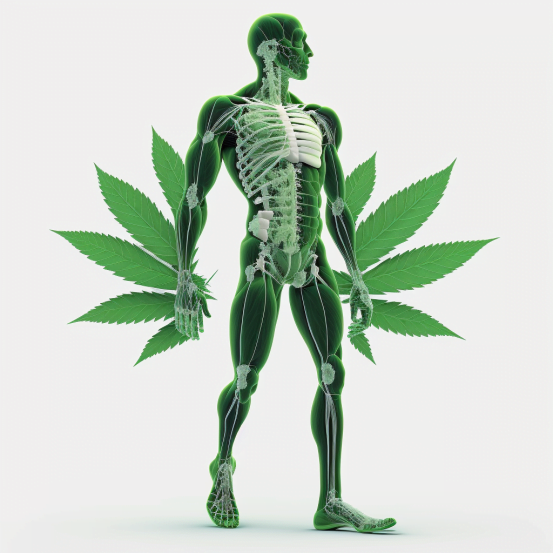English
1.Your endocannabinoid system may affect your metabolic health
Dr George Kunos’ research group at the NIH’s Neuroendocrinology Section presented some of their findings on a dual-target CB1r (cannabinoid type 1 receptor) antagonist that can also affect other receptors involved in liver fibrosis and inflammation. Liver dysfunction is often due to an interaction between alcoholic liver disease, viral infection and type 2 diabetes, obesity and metabolic syndrome (fatty liver). The research group synthesised a group of compounds that essentially realise functional benefits related to fat loss, improved blood sugar metabolism and fatty liver, with much lower penetration into brain tissues. These compounds inhibit CB1 receptor action strictly in the periphery (liver, fat, muscle), while avoiding adverse brain/behavioural effects. Although still at an early stage of development, the compounds offer hope and open the door to the possibility that natural compounds may be able to influence the endocannabinoid system to improve obesity, metabolic syndrome, abdominal/visceral fat and carbohydrate intolerance. In other words, we might be able to regain some of that seemingly unstoppable metabolism of our youth that allowed us to eat more liberally while staying “lean and slim.
2.Different cannabis compounds can affect CB1 receptors differently
D. Lu, HI Ali et al. from Texas A&M and UConn discussed a new technique for studying and characterising compounds in cannabis (and other substances) that may affect the CB1 receptor in a different way than THC. THC is known as a CB1 agonist or orthosteric ligand, meaning that THC is the “key” that fits snugly into the CB1 receptor site, or lock”. However, allosteric ligands are compounds that can bind to the receptor at an alternative site, or sites away from the main lock” to affect the intensity, duration or character of the biological effect downstream of that receptor. In other words, the use of these allosteric receptor sites instead of orthosteric (traditional binding sites) allows for more nuanced responses that accentuate some effects (e.g. anti-inflammatory, anti-pain, etc.), while avoiding other adverse, secondary effects (e.g. psychoactivity, anxiety, paranoia, etc.).
3.CBD may have anti-psychotic properties
Schizophrenia is a psychiatric disorder characterised by delusions, hallucinations, confusion and disorganised thinking. The usual pharmaceutical treatment of schizophrenia involves the use of drugs that target dopamine receptors. Although THC is the main cannabinoid responsible for some of the adverse effects of marijuana-induced anxiety, paranoia and hallucinations, CBD has been found to have good therapeutic potential in these areas. J. Renard, J. Loureiro et al. from the University of Western Ontario presented new findings that support the antipsychotic properties of CBD, including some of the underlying molecular signalling mechanisms in specific parts of the brain.
4.CBD may also be beneficial for a number of neurodegenerative disorders
C.E. Herron et al. at University College Dublin, Ireland, studied CBD, the non-toxic component of cannabis, as a potential therapeutic agent for various neurodegenerative disorders, including Alzheimer’s dementia. CBD exerts anti-inflammatory and neuroprotective effects on toxic beta-amyloid plaques and tau proteins in cultured brain cells. These new data were transferred to an animal model, showing that CBD pre-treatment was able to protect and restore long-term potentiation (LTP) deficits critical for memory function within the hippocampus of the brain. These positive effects were observed despite no changes in tau protein or beta-amyloid oligomerisation.
5.CBG could minimise muscle wasting caused by various illnesses
D.I. Brierley et al. from the University of Reading, Berkshire, UK, presented interesting data on how CBG (cannabigerol) was able to mitigate the muscle wasting typical of the cancer anorexia-cachexia syndrome that occurs in up to 80% of patients with advanced cancer. This comorbidity not only decreases quality of life and response to treatment, but also increases mortality. A considerable body of evidence has emerged demonstrating that both cancer and chemotherapy induce progressive muscle loss through systemic inflammation, metabolic dysfunction and the cytotoxic effects of the chemotherapy itself. Recent data show that oral administration of CBG to cisplatin chemotherapy-treated rats not only increases feeding behaviour, but also partially reverses the loss of body weight and muscle mass caused by cisplatin. The ever-important type IIA and IIx muscle fibres (known to be the most responsive to loaded exercise, with high strength capacity, growth potential and fatigue resistance) appeared to be relatively unharmed in the CBG-treated group. Further work is needed to investigate the underlying mechanisms of this protective effect. It could be affecting the pathways that control muscle protein synthesis/anabolism, or protein degradation/catabolism.
Relaten articles :
Published by Sakul
15/02/2023choose and buy cannabis seeds from our offer
our pleasure






























